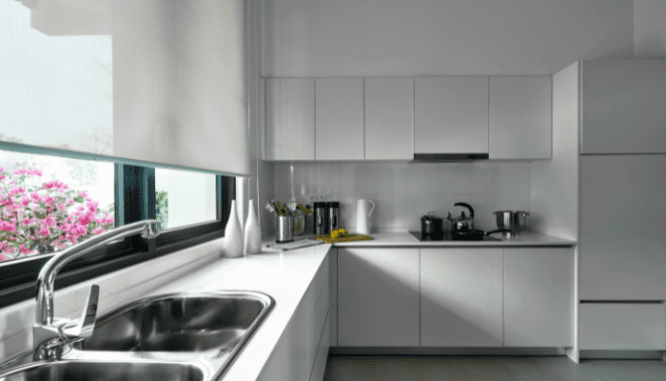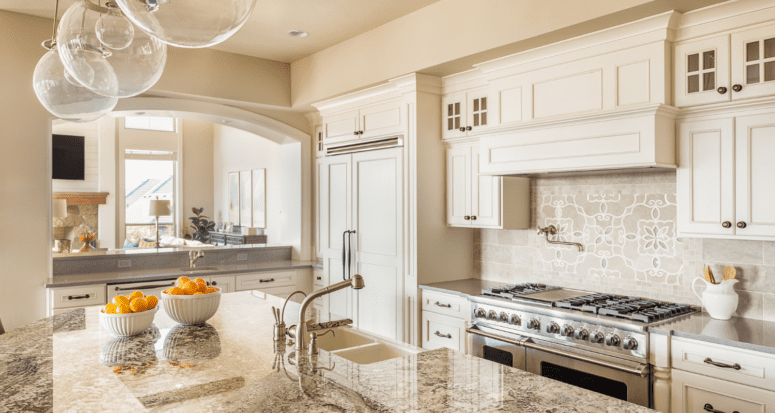Over the Stainless Steel Look? Swap to Seamless Panel-Ready Appliances
- Published on
- 5 min read
-
 Lori Lovely Contributing AuthorClose
Lori Lovely Contributing AuthorClose Lori Lovely Contributing Author
Lori Lovely Contributing AuthorLori Lovely edited the Real Estate Home section for the Indianapolis Star and covered the annual Dream Home construction and decor for Indianapolis Monthly magazine. She has written guides for selling houses and more.
It’s well known that kitchens sell houses. A stunning cooking space complete with high-end appliances attracts more buyers and can even inspire them to increase their offer price.
While stainless steel has long been homeowners’ finish of choice, an increasingly popular design is coming for the throne: panel-ready appliances. These appliances are designed to blend seamlessly with cabinetry, making them ideal for open floor plans and custom kitchens.
“Homeowners want a demure piece of furniture, not appliances that scream, ‘I’m a kitchen!’ They want Meryl Streep, not Carol Channing,” comments Mark Williams, owner of Mark Williams Design, a firm consisting of architectural and interior designers with experience dating to 1998. His and his team’s work has been featured in Southern Living, Kitchen Trends, Home, Atlanta Home, and other national magazines.
Yearning to add these chameleon appliances to your kitchen? We’ll fill you in on the trend’s trajectory, cost, return on investment, and more below.

What are panel-ready appliances?
Panel-ready appliances are designed to accommodate a custom front that matches the kitchen cabinets for a cohesive look that’s personalized and high-end.
The appliances themselves have an unfinished front, though some come with basic panels available in different colors. It’s up to a homeowner’s cabinet designer to build custom panels for the appliances that match the kitchen cabinetry. The application involves a complicated process requiring bolts, brackets, and other parts; it’s best left to the pros.
Fully integrated vs. built-in panel ready appliances
There are two main types of panel-ready appliances: fully integrated and built-in, or overlay. Fully integrated panel-ready appliances include special hinges that allow the appliance face to sit flush with the cabinets.
Williams shares that this panel style allows the appliances to “totally disappear,” blending seamlessly with the cabinets. Fully integrated panel-ready appliances are design professionals’ top choice, though they’re more expensive for homeowners.
On the flipside, built-in panel-ready appliances are more affordable yet more noticeable. “You can see a metal flange around the edge,” Williams explains. “It’s obviously an appliance.”
Panel-ready appliances cost more than traditional designs
Custom always costs more than off-the-shelf, and appliances are no exception. Since you must hire a cabinet designer to create matching panels for these appliances, you’ll pay significantly more than you would for standard appliances.
Pricing for a built-in panel-ready refrigerator starts around $4,000 but can quickly reach $8,000 to $10,000. With installation costs, it’s not unusual to see prices go significantly higher. Because of the size and the custom panels, these appliances often require special installation, which adds to the price tag.
By comparison, a stainless steel GE Profile refrigerator comes in a little lower, at around $3,000, while the base price for a high-end Sub-Zero refrigerator is $7,000.
Whether you opt for seamless, integrated panel-ready appliances, or the less subtle overlay design impacts price, as well. Overlay refrigerators start at a mid-tier price, while fully integrated units are the most expensive choice.
“Panel-ready [overlay] are the least expensive because they stick out,” Williams says. “There’s a big price difference for integrated appliances.”

Panel-ready appliances add value, but not as much as you might expect
Considering that Americans spend between 30 minutes and 60 minutes per day in their kitchens doing meal preparation, it comes as no surprise that an updated kitchen complete with panel-ready appliances can boost your home’s value and marketability at resale. However, it’s important to note that high-end kitchen remodels tend to yield lower return on investment than mid-range kitchen remodels.
Data from Remodeling Magazine reveals that a minor, mid-range kitchen remodel recoups 83% of project costs, while a major, high-end kitchen remodel recoups only 54% of costs.
Your home’s price point also influences how much value and marketability panel-ready appliances will add to your home at resale. The key is to keep your kitchen remodel in line with the value of your home, as well as your neighborhood. Buyers won’t want to overpay simply because the kitchen features integrated panel-ready appliances.
If your home belongs to the luxury market where buyers expect high-end appliances, panel-ready appliances can be a major selling point. Otherwise, it’s best to consult a top real estate agent to gauge if panel-ready appliances will positively impact your future home sale. They’ll know what’s trending in your market and how much more buyers at your home’s price point are willing to pay for custom appliances.
Popularity contest: stainless steel vs. panel-ready
Williams shares that more and more of his design firm’s clients are requesting panel-ready appliances over stainless steel. If you’re deciding between these top appliance styles, consider the following:
Stainless steel appliances
Pros:
- Contemporary, industrial look that many homeowners find appealing
- More affordable models available than panel-ready appliances
- Easy to mix and match appliance brands and maintain a cohesive look
Cons:
- Show fingerprints and smudges, requiring regular cleaning
- Scratch and dent easily
- Offer a less custom look than panel-ready appliances
Panel-ready appliances
Pros:
- Today’s go-to style for custom kitchens
- Perfect for open floor plans and spaces where the kitchen is on display
- Many high-quality appliances come in the panel-ready style
Cons:
- Cabinet faces can make appliance doors
- One of the most expensive appliance options
- Additional cost for custom panels required

Your kitchen, your appliances, your choice
Beyond value-add, consider the “joy factor.” A National Association of Realtors’ Remodeling Impact Study indicates that kitchen remodels scored a 9.6 Joy Score, with 65% of homeowners expressing more enjoyment of their homes afterward.
From Williams’ perspective, the kitchen is always a good place to invest.
“You see, touch, feel, and use kitchens and baths every day. They sell homes, so it’s worthwhile to throw some money around.”
Header Image Source: (Breadmaker / Shutterstock)
